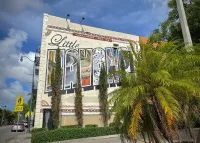A banana is an edible fruit, botanically classified as a berry, that grows from treelike herbaceous flowering plants of the genus Musa. Distinctions are made between dessert bananas and cooking bananas (plantains). Bananas vary in size, color, and firmness, generally featuring an elongated, curved shape with soft, starchy flesh encased in a peel that changes color upon ripening. They grow in upward clusters. Modern seedless bananas are cultivated from two wild species, Musa acuminata and Musa balbisiana, or their hybrids.
1910: Banana Peel Slip Comedy Routine
In 1910, An American comedy recording featured the character "Uncle Josh" describing slipping on a banana peel.
1913: Banana in de Chirico's Painting
In 1913, Giorgio de Chirico's painting "The Uncertainty of the Poet" used the banana's suggestively phallic shape in artworks.
1923: Release of "Yes! We Have No Bananas"
In 1923, the song "Yes! We Have No Bananas" by Frank Silver and Irving Cohn was released. It became the best-selling sheet music in history.
1925: Abacá Cultivation in Sumatra
In 1925, abacá was first cultivated on a large scale in Sumatra under the Dutch.
1929: Abacá Plantings in Central America
In 1929, abacá plantings started in Central America sponsored by the U.S. Department of Agriculture.
1947: Cheesman's Reclassification of Bananas
Starting in 1947, Ernest Cheesman published a series of papers demonstrating that Linnaeus's Musa sapientum and Musa paradisiaca were cultivars and descendants of Musa acuminata and Musa balbisiana and recommended abolishing Linnaeus's species in favor of reclassifying bananas according to morphologically distinct groups of cultivars.
1955: Genome-Based Nomenclature System Proposed
In 1955, Norman Simmonds and Ken Shepherd proposed a genome-based nomenclature system, which aimed to eliminate inconsistencies in banana classification. However, the original names are still recognized by some authorities, leading to confusion.
1960: Cavendish Replaces Gros Michel
Prior to 1960, almost all commercial banana production centered on the Gros Michel cultivar, which was highly susceptible to Panama disease. Cavendish was chosen as its replacement because it produces the highest quality fruit among resistant cultivars.
1967: "The Velvet Underground & Nico" Album Cover
In 1967, the debut album of The Velvet Underground featured a banana made by Andy Warhol on the cover. The design allowed the listener to "peel" this banana to find a pink, peeled banana on the inside.
1989: Guerilla Girls' Screenprint
In 1989, the feminist Guerilla Girls created a screenprint with two bananas arranged to form a "0" to answer the question in the artwork, "How many works by women artists were in the Andy Warhol and Tremaine auctions at Sotheby's?".
1995: Development of the Banana Equivalent Dose
In 1995, the banana equivalent dose of radiation was developed as a simple teaching-tool to educate the public about the natural, small amount of K-40 radiation occurring in everyone and in common foods.
2000: Questionable Banana Phytoliths Date
Around 2000 BC, an introduction date is unlikely as this was long before there was any evidence of agriculture in East Africa. Polyploid banana cultivars are sterile and do not spread without human cultivation.
2000: Possible Early Dispersal of Bananas
Around 2000 BCE, Phytoliths recovered from the Kot Diji archaeological site in Pakistan suggested that bananas were known to the Indus Valley civilisation. This may indicate very early dispersal of bananas by Austronesian traders by sea.
2003: Denham et al. Investigation on Banana Domestication
Various investigations like Denham et al. in 2003, determined that by the early to middle Holocene era, the domestication process of Bananas was complete.
2009: Cavendish Bananas Face Disease Threats
In 2009, disease threatened the production of the Cavendish banana worldwide. Researchers started focusing on creating a disease-resistant banana, like the Taiwanese Cavendish or Formosana, through hybridization and genetic engineering.
2011: Phylogenomic Analysis of Musaceae Family
In 2011, a phylogenomic analysis using nuclear genes revealed the phylogeny of some representatives of the Musaceae family, highlighting major edible kinds of bananas.
2013: World Exports of Bananas and Plantains
As reported for 2013, total world exports were 20 million tonnes of bananas and 859,000 tonnes of plantains. Ecuador and the Philippines were the leading exporters.
2016: Growth of Certified Banana Production
By 2016, banana production certified by voluntary sustainability standards like Rainforest Alliance and Fairtrade represented 36% of banana exports, primarily in countries focused on the export market.
2018: Bananas Lead in Fruit Export Volume
As of 2018, bananas are exported in larger volume and to a larger value than any other fruit.
2019: Controversy over Natalia LL's Exhibition
In 2019, an exhibition of Natalia LL's video and photographs at the National Museum in Warsaw was taken down and the museum's director reprimanded because the video showed a woman "sucking on a banana".
2024: Global Warming Threatens Banana Supply
In 2024, the economist Pascal Liu of the FAO described the impact of global warming as an "enormous threat" to the world supply of bananas.
2024: Identification of M. acuminata Subspecies
In 2024, work identified three subspecies of M. acuminata (banksii, malaccensis, and zebrina) as contributing to the subgenomes of triploid cultivated bananas.
July 2025: 85 Musa Species Recognized
As of July 2025, Plants of the World Online recognizes approximately 85 species of Musa. Several produce edible fruit, while others are cultivated as ornamentals.
Mentioned in this timeline

Andy Warhol - was a pivotal American artist film director...
India officially the Republic of India is located in South...
Africa is the second-largest and second-most populous continent comprising of...
China officially the People's Republic of China PRC is an...
Australia officially the Commonwealth of Australia is a country encompassing...

Miami is a major coastal city located in Florida United...
Trending

6 months ago Oscar Piastri leads in F1 Miami Grand Prix 2025; Verstappen trails behind him.
44 minutes ago Peter Stormare's Surprise 'General Hospital' Appearance: Mystery Man Revealed Behind Felicia!
2 hours ago Rob Riggle Hosts 'American Valor' Veterans Day TV Special Honoring US Service Members.

3 hours ago Letitia James Seeks Dismissal of Fraud Case, Citing Trump's Animus As Fuel
3 hours ago Ireland faces Japan at Aviva Stadium: Farrell announces team for anticipated rugby match.
3 hours ago Journey Announces Farewell Tour After 50 Years, But Neal Schon Hints at More
Popular

Nancy Pelosi is a prominent American politician notably serving as...

Zohran Kwame Mamdani is an American politician currently serving as...

William Franklin Graham III commonly known as Franklin Graham is...

Chuck Schumer is the senior United States Senator from New...

Gavin Newsom is an American politician and businessman currently serving...
Abigail Spanberger is an American politician who served as the...